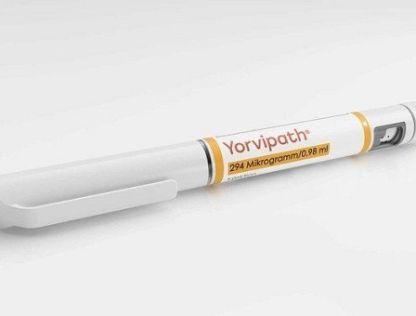Palopegteriparatide Dosage
Medically reviewed by Drugs.com. Last updated on Oct 14, 2024.
Applies to the following strengths: 168 mcg/0.56 mL; 294 mcg/0.98 mL; 420 mcg/1.4 mL
Usual Adult Dose for:
Additional dosage information:
Usual Adult Dose for Hypoparathyroidism
Initial dose: 18 mcg subcutaneously once a day
Maintenance dose: Increase or decrease by 3 mcg subcutaneously once a day, with goal of maintaining serum calcium within a normal range without supplementation.
- The recommended dosing range is 6 mcg to 30 mcg subcutaneously once a day.
- Do not increase dose more often than every 7 days, or decrease dose more often than every 3 days.
Comments:
- Refer to the manufacturer product information for dosing, titration, and monitoring recommendations.
- If adequate response is not achieved with maximum dose, consider adding or restarting calcium and/or active vitamin D and/or seek other treatment options.
- Some patients may require dose increases over time to maintain the same therapeutic effect.
- Patients may continue calcium supplementation sufficient to meet daily dietary requirements.
- Monitoring of serum calcium is recommended regularly during treatment.
- Limitations of use:
- Titration recommendations were only evaluated in patients who first achieved an albumin-corrected serum calcium of at least 7.8 mg/dL using calcium and active vitamin D treatment.
- This drug was not studied for acute post-surgical hypoparathyroidism.
Use: For the treatment of hypoparathyroidism
Renal Dose Adjustments
Mild, moderate, or severe renal dysfunction (estimated GFR at least 15 mL/min/1.73 m2): No adjustment recommended.
Liver Dose Adjustments
Data not available; studies were not conducted in patients with liver dysfunction.
Comments:
- Mild to moderate liver dysfunction is not expected to have a clinically significant impact on drug exposure.
Dose Adjustments
Dose adjustments are individualized based on serum calcium. Refer to the manufacturer product information for dosing tables and titration schemes (flowcharts).
Precautions
CONTRAINDICATIONS:
- Hypersensitivity to the active component or to any of the ingredients (reactions such as anaphylaxis, angioedema, and urticaria have been observed with parathyroid hormone analogs)
Safety and efficacy have not been established in patients younger than 18 years.
Consult WARNINGS section for additional precautions.
Dialysis
Data not available
Other Comments
Administration advice:
- For subcutaneous use
- Consult the manufacturer product information for full recommendations regarding laboratory testing, dose adjustment, and administration advice.
- Within 2 weeks before the first dose, confirm serum 25(OH) vitamin D and albumin-corrected serum calcium are within the recommended ranges.
- On the day of initiation (or up-titration), adjust the dose of vitamin D and calcium supplements as recommended in the manufacturer product information.
- Administer this drug in the abdomen or front of thigh (rotate injections site daily); ensure patient can sit or recline due to potential for orthostatic hypotension.
- Use only 1 injection to achieve recommended daily dose; use of 2 injections may increase the risk of unintended changes in serum calcium levels.
- Assess serum calcium 7 to 10 days after the first dose, and after any dose changes related to the drug or supplementation (i.e., active vitamin D or calcium); adjust dosing as per manufacturer recommendations.
Missed dose:
- If a dose is missed by less than 12 hours, administer as soon as possible; if more than 12 hours have passed, skip the dose and take the next dose as scheduled.
- If treatment is delayed or interrupted for 3 days or more:
- Evaluate patient for signs and symptoms of hypocalcemia and consider assessing serum calcium.
- If indicated, resume treatment with (or increase the dose of) calcium supplements and active Vitamin D.
- Resume therapy at the previous dose as soon as possible after interruption; measure serum calcium within 7 to 10 days and adjust dosage as per manufacturer recommendations.
Storage requirements:
- Store refrigerated at 2C to 8C (36F to 46F) until first use in original packaging to protect from light.
- After first use, store at room temperature below 30C (86F) and then discard after 14 days.
- Do not freeze. Keep away from heat.
Reconstitution/preparation techniques:
- The product is supplied as a pen for subcutaneous injection; attach a pen needle prior to administration.
- Inspect product for particulate matter or discoloration before administering; discard if cloudy or colored.
- Pen types, strengths, and deliverable dose ranges may vary; review the manufacturer product information.
General:
- Train patients and/or caregivers on the preparation and administration of this drug before first use.
Monitoring:
- Cardiovascular: For signs/symptoms of orthostatic hypotension (during therapy)
- Metabolic: Serum calcium levels (7 to 10 days after the first dose, after any dose change, and at least every 4 to 6 weeks or as indicated during maintenance therapy); for signs/symptoms of hypocalcemia or hypercalcemia (during maintenance therapy)
Patient advice:
- Read the US FDA-approved patient labeling (Medication Guide and Instructions for Use).
- Use only 1 subcutaneous injection to achieve the once a day recommended dosage; rotate injection sites.
- Report use of any digoxin-containing medication to your health care provider and follow monitoring recommendations.
- Promptly contact your health care provider if symptoms of hypercalcemia or hypocalcemia develop.
- Report any signs or symptoms potentially consistent with bone cancer (e.g., osteosarcoma).
- Seek immediate medical attention if signs/symptoms of hypersensitivity reaction(s) occur.
- Females of childbearing potential: Report pregnancy during treatment to your health care provider; a safety study monitoring pregnancy outcomes is available.
More about palopegteriparatide
- Check interactions
- Compare alternatives
- Side effects
- During pregnancy
- Drug class: parathyroid hormone and analogs
Patient resources
Other brands
Professional resources
Related treatment guides
Further information
Always consult your healthcare provider to ensure the information displayed on this page applies to your personal circumstances.


